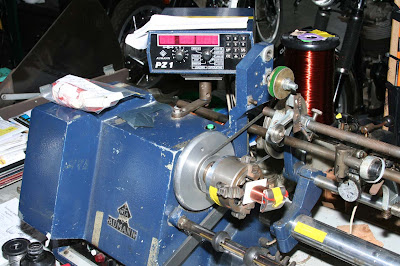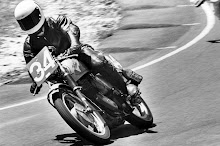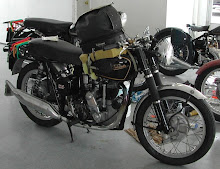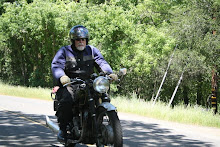The magneto....more commonly BTH, Lucas come to mind, but ML, Scintilla, Bosch, Norris are just some of the multitude of other makes....
If you've a Britsh bike, then the first two are likely your cup of tea....
My two Velocettes...I culled the fleet down over the years, use a BTH on my KSS/scrambler road special and a K1F Lucas on my 1960 Venom.
So I've a foot in both camps and have had my share of mag problems over the years...with then, an accumulated pile of older magnetos, parts etc, I used to rebuild, no that's not the word..I use to pull them apart and re-assemble them with whatever I had to get a good spark and my sole criteria for a "good" magneto was one that you could rock the armature back and forth and a nice fat blue spark cracked across the points of a spark plug attached to the plug lead....
Times have changed...all countries have people repairing, rebuilding and supplying re built magnetos to the classic motorcycle movement.
Many just plain and simply...don't do a good job...
Despite modern wire for the low and high tension coils, and with modern insulation...they fail...
Some of these rebuilders don't understand the correct dv/dt required for the capacitor.
A trip to the local electronic shop presents you with a multitude of modern capacitors to replace the aged original BTH and Lucas versions.
But all are not equal in the role they must play in the motorcycle magneto armature....
Lecture over....well, not a lecture, just DQ up on his soapbox again...
Here in Australia, Tim Thearle has built up a reputation over the years as the man to do magnetos...
He lives out at Orange, some 200km west of Sydney where I live...he's in the Velocette Owners Club so I see a bit of him there and he's taken over some of the specialist supply items from me as I closed my automotive/motorcycle instrumentation business...
A look at his advert in the Old Bike Australasia magazine gives an insight...
I did a preliminary visit the other year and finished it off photographically last week...
So we'll follow Tim around the general rebuilding and testing of a magneto...
Firstly...how to contact Tim....
Tim sets up to rewind the armature of a normal rotating coil type magneto...
Firstly the low tension windings with thicker diameter wire, then the high tension windings with thinner wire and more turns of them.
Tim's latest advert with contact details at early 2018, following his move to a new addess several years back...
I mentioned that even modern wound coils sometimes fail....the following two pics show the arcing that occurred in the windings of a recently wound coils taken from magnetos sadly restored by others... the black areas are where the arcing occurred.
Tim works on the assembled armature...
Setting up the armature to run true...less than 0.002" run-out in a collet chuck situation ensures little chance of the armature "poling" in the magneto body against the magnets.
The gauss of the magnet can be checked and the magnets remagnetised...
Then to the test equipment and the spark is tested with a larger than normal air gap...up to 3mm or so and with the armature turning over at low rpm...100-300rpm.
Of interest we tested the speed of a Velocette Venom ( 500cc model) crank.
Velocette's have a low kick starter ratio and this can be another problem in kick starting with a suspect magneto.
The figure is 400rpm....a 350 Viper with a smaller engine sprocket would spin faster....
So a magneto needs a good spark at these low starting rpm to avoid a bike becoming a notoriously difficult starter...
The setup has a graduated degree plate and a spinning pointer set to have its tip some 3mm clear of the plate so the spark can be observed as it arcs to the plate and the degree value read off.
This allows you to observe when a spark starts at what rpm and if you have a magneto with electronic advance built into the circuit such as on the latest new BTH electronic magnetos, you can see the amount of advance.
Tim had one to test .
These are illustrated below..
Tim with the modern BTH on test...this version is of the magdyno type.
The unit static, showing the pointer attached to the centre of the variable speed electric motor with the pointer in the approximate position that a spark will occur.
At speed...I was able to catch the spark ( used 1/500 second...couldn't use a faster speed due to the lighting conditions...as it was I had 6400 ISO on my Canon EOS 550D digital camera and an aperture of around f2, so the depth of field was limited).
Another view of the test setup.
The new BTH at 1000rpm ( 2000rpm crankshaft speed) showing 25,000Kv discharge...
At around 150rpm ( 300rpm crankshaft speed) the discharge is 2000kv.
An older BTH magneto, just overhauled on test....
Tim with wife Marion relaxing at an Australian Velocette Owners Club National Rally.....

































































